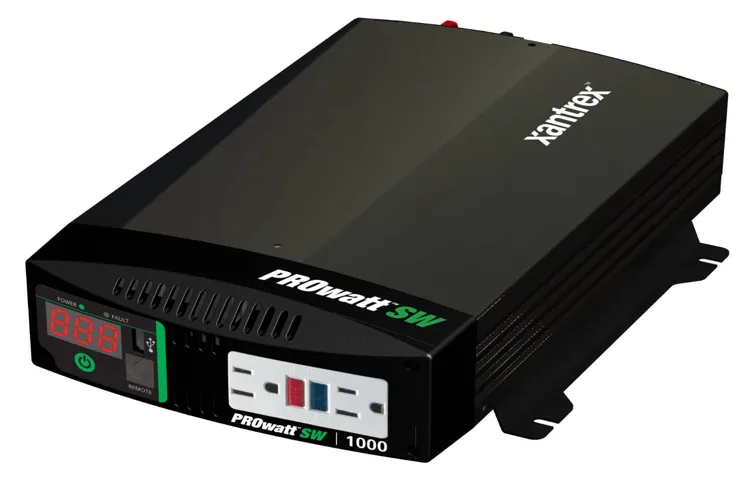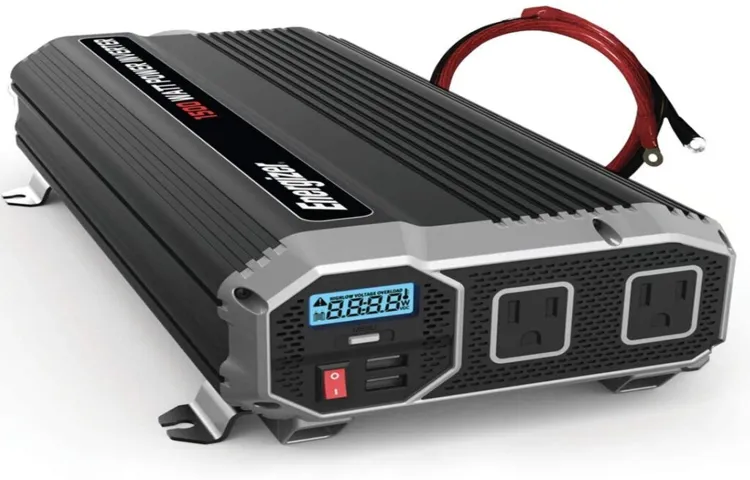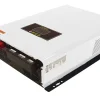How much power does a 400-watt inverter use? It’s a question that often pops up when considering purchasing an inverter for your power needs. Inverters are essential devices that convert DC power from sources such as batteries or solar panels into AC power, allowing you to power appliances and electronics in places where grid power is not readily available. But understanding how much power an inverter consumes can help you make informed decisions about its usage and the overall power requirements of your setup.
To break it down, a 400-watt inverter typically draws around 400 watts of power from its DC input source to provide 400 watts of AC power to your devices. However, it’s essential to consider that inverters are not 100% efficient, meaning that they consume some power in the conversion process. In general, the efficiency of inverters ranges from 70% to 95%, with higher-quality inverters often offering better efficiency.
So, let’s say you have a 400-watt inverter with an efficiency of 90%. This means that it would draw approximately 444 watts from its DC power source to produce 400 watts of AC power, with the remaining 44 watts being lost as heat in the conversion process. Keep in mind that these numbers can vary depending on the specific model and brand of the inverter.
Understanding the power consumption of your inverter can be crucial when determining the capacity of your DC power source, whether it’s a battery bank or solar panels. If your inverter consumes a significant amount of power, it will drain your DC source more quickly, requiring larger or additional power sources to meet your needs. Additionally, if you plan to use your inverter for extended periods, it’s essential to consider its standby power consumption.
Inverter standby power refers to the power consumed when the inverter is not actively providing power to any devices but is still turned on. Some inverters have a standby power consumption of less than 1 watt, while others may consume up to several watts. This standby power can add up over time, especially if you leave your inverter on for extended periods when not in use.
In conclusion, a 400-watt inverter typically draws the same amount of power from its DC input source to provide 400 watts of AC power to your devices. However, the efficiency of the inverter plays a role in how much power it actually consumes. Understanding the power consumption of your inverter can help you estimate your power needs and choose the appropriate DC power source for your setup.
Table of Contents
Introduction
If you’re wondering how much power a 400-watt inverter uses, you’ve come to the right place. An inverter is a device that converts DC (direct current) power into AC (alternating current) power, allowing you to use household appliances and electronics in your car or when you’re off the grid. The power consumption of a 400-watt inverter depends on various factors, including the load you connect to it and the efficiency of the inverter itself.
Generally, the power consumption of an inverter can be estimated by multiplying its wattage by the amount of time it’s used. So, if you have a 400-watt inverter and you use it for one hour, it would consume 400 watt-hours of energy. However, it’s important to remember that the efficiency of the inverter will affect this estimation.
Higher efficiency inverters will consume less power.
Understanding Power Consumption
power consumption, energy efficiency, electricity usage, sustainability, reduce carbon footprint

What is a 400-Watt Inverter?
400-Watt Inverter Introduction: Are you in need of a reliable power source when you’re on the go? Look no further than a 400-watt inverter! This compact and versatile device can turn your car’s battery into a portable power supply. Whether you’re camping, road tripping, or experiencing a power outage, a 400-watt inverter is a game changer. But what exactly is a 400-watt inverter, and how can it benefit you? In this blog post, we will delve into the world of 400-watt inverters and explore their features, uses, and advantages.
So, let’s get started!
Calculating Power Consumption
If you’re wondering about the power consumption of a 400 watt inverter, you’ve come to the right place. First of all, it’s important to note that an inverter is a device that converts direct current (DC) power from a battery into alternating current (AC) power, which is what most household appliances and electronics use. The wattage of the inverter indicates the maximum amount of power it can supply.
So, a 400 watt inverter can handle up to 400 watts of load. However, it’s crucial to understand that the power consumption of an inverter is not constant. It depends on the load connected to it.
For example, if you connect a device that requires 100 watts of power, the inverter will only draw about 100 watts from the battery. In general, the power consumption of an inverter can be calculated by multiplying the voltage (in volts) and the current (in amps) drawn by the load connected to it. So, to determine the power consumption of your 400 watt inverter, you need to consider the specific devices or appliances you plan to connect to it.
Power Consumption Formula
power consumption, formula, calculating power consumption Calculating power consumption is essential for understanding the energy usage of a device or appliance. The power consumption of a device refers to the amount of electrical energy it consumes over a given period of time. By knowing the power consumption of a device, you can make informed decisions about its usage and estimate the cost of running it.
The formula for calculating power consumption is straightforward: power consumption equals the product of the device’s power rating and the amount of time it is used. The power rating is usually listed on the device itself or in its user manual and is measured in watts. The amount of time used can be measured in hours, days, or any other convenient unit depending on the context.
For example, let’s say you have a television with a power rating of 100 watts and you use it for 4 hours a day. To calculate the daily power consumption, you would multiply 100 watts by 4 hours, giving you a total of 400 watt-hours, or 0.4 kilowatt-hours (kWh) since there are 1,000 watt-hours in a kilowatt-hour.
Understanding how to calculate power consumption can help you become more aware of your energy usage and make more sustainable choices in your daily life.
Calculating Power Consumption of a 400-Watt Inverter
power consumption, 400-Watt inverter, calculating
Factors Affecting Power Consumption
Have you ever wondered about the power consumption of a 400-watt inverter? Well, the amount of power a 400-watt inverter uses can vary depending on a few factors. One of the main factors is the efficiency of the inverter itself. Inverters are not 100% efficient, which means that they will consume more power than they actually output.
Another factor that can affect power consumption is the load that is connected to the inverter. If you are using a device that requires a lot of power, the inverter will have to work harder and consume more power. Additionally, the length and size of the cables used to connect the inverter to the power source and the load can also impact power consumption.
Longer and thinner cables can result in power loss and higher consumption. So, if you’re wondering how much power a 400-watt inverter uses, remember to consider these factors to get a more accurate estimate.
Device Efficiency
power consumption, device efficiency, factors affecting power consumption. One of the key considerations when using electronic devices is their power consumption. Whether it’s a smartphone, laptop, or tablet, we all want our devices to last as long as possible on a single charge.
However, there are several factors that can affect power consumption. One of the most significant factors is the screen brightness. The brighter the screen, the more power it requires, so reducing the brightness can help conserve battery life.
Another factor is the number of apps and processes running in the background. Running multiple apps or keeping unnecessary processes active can drain the battery quickly. It’s important to close any unused apps and disable unnecessary features to optimize power usage.
Additionally, the strength of the device’s network connection can also affect power consumption. When the signal is weak, the device will use more power to maintain the connection. So, it’s advisable to switch to a stronger network when possible.
Lastly, the age and condition of the battery itself can impact power consumption. Over time, batteries lose their capacity, leading to decreased performance. It’s important to periodically replace batteries or ensure they are in good condition to maximize device efficiency.
By considering and managing these factors, we can prolong the battery life of our electronic devices and make them more power-efficient.
Load Capacity
“Factors Affecting Power Consumption in Load Capacity” When it comes to load capacity, there are several factors that can affect power consumption. One of the main factors is the weight of the load. The heavier the load, the more power is needed to move it.
This is because the motor of the machine or vehicle has to work harder to overcome the force of gravity on the load. So, if you have a heavy load, you can expect it to consume more power. Another factor that can affect power consumption is the distance the load needs to be moved.
The longer the distance, the more power is required to move the load. This is because the motor has to work for a longer period of time, and the machine or vehicle has to maintain a consistent speed over the distance. So, if you need to move a load a long distance, be prepared for it to consume more power.
The speed at which the load is moved is also a factor in power consumption. If the load needs to be moved quickly, more power is needed to achieve the desired speed. This is because the motor has to exert more force to accelerate the load to the required speed.
So, if you need to move a load quickly, expect it to consume more power. Additionally, the type of surface the load is being moved on can affect power consumption. A smooth, even surface will require less power to move the load compared to a rough or uneven surface.
This is because the friction between the load and the surface affects the amount of power needed to overcome it. So, if you are moving a load on a rough surface, it may consume more power. In conclusion, when considering load capacity, it is important to take into account factors that can affect power consumption.
Battery Condition
battery condition, power consumption
Common Appliances and Their Power Consumption
If you’re considering using a 400-watt inverter, it’s important to understand how much power it consumes. A 400-watt inverter is designed to convert DC power from a battery into AC power that can be used to run household appliances or electronic devices. The power consumption of the inverter itself depends on several factors, including the efficiency of the inverter and how much power is being drawn from it.
In general, a 400-watt inverter will consume more than 400 watts of power from the battery due to conversion losses. The exact power consumption will vary depending on the specific model of the inverter. To determine the power consumption of your 400-watt inverter, you can check the specifications provided by the manufacturer or consult the user manual.
It’s always a good idea to have a reliable power source or backup plan in case the inverter consumes more power than expected.
Examples of Appliances and Their Power Ratings
household appliances, power ratings, energy consumption, examples
Conclusion
In conclusion, the amount of power consumed by a 400 watt inverter can be likened to the humble act of savoring a piece of rich and decadent chocolate cake. Just as this delectable dessert tantalizes our taste buds, the 400 watt inverter satisfies our technological cravings by converting DC power into usable AC power. However, unlike the fleeting indulgence of a chocolate cake, the 400 watt inverter is a wise and efficient choice, offering a taste of power without gluttonously devouring energy.
So, next time you ponder the power consumption of a 400 watt inverter, remember the sweet analogy of the chocolate cake, and relish in the knowledge that this little gadget won’t leave you with a guilty energy conscience.”
Optimizing Power Consumption
power consumption, optimizing power consumption, common appliances, energy-efficient appliances, reducing energy usage In today’s world, where energy conservation and reducing carbon footprint are becoming increasingly important, optimizing power consumption in our homes is essential. One of the best ways to do this is by understanding the power consumption of our common appliances and making smarter choices. Let’s start with the refrigerator, one of the most power-hungry appliances in our homes.
By purchasing an energy-efficient model, you can significantly reduce its power consumption. Another energy hog is the air conditioner. Considering the size and efficiency of your unit can make a big difference in energy usage.
It’s also important to think about our smaller appliances, such as microwaves, toasters, and coffee machines. These can consume a surprising amount of power, even when they are not in use. Investing in energy-efficient models or using power strips with on/off switches can help mitigate this.
By paying attention to the power consumption of our common appliances and making smarter choices, we can not only reduce our energy usage but also save money in the long run.
FAQs
What is an inverter and how does it work?
An inverter is an electronic device that converts DC power to AC power. It works by using electronic components to switch the DC power on and off at a rapid rate, creating an AC waveform.
What is the power rating of a 400 watt inverter?
The power rating of a 400 watt inverter is 400 watts. This means that it can provide a continuous output power of 400 watts to devices connected to it.
How much power does a 400 watt inverter consume when it is idle?
When a 400 watt inverter is idle, meaning there are no devices connected to it and it is not actively providing power, it consumes a small amount of power called the standby power. This standby power can be around 1-10 watts, depending on the specific model of the inverter.
Can a 400 watt inverter power a refrigerator?
It depends on the power requirements of the refrigerator. A 400 watt inverter may be able to power a small refrigerator or a mini fridge, but it may not be sufficient to power a full-size refrigerator or one with a high power demand.
What kind of devices can be powered by a 400 watt inverter?
A 400 watt inverter can power a wide range of devices, such as laptops, smartphones, tablets, LED lights, small fans, and small kitchen appliances like blenders or coffee makers. It is important to check the power requirements of the specific device to ensure compatibility with the inverter.
Can a 400 watt inverter be connected to a car battery?
Yes, a 400 watt inverter can be connected to a car battery. Most 400 watt inverters are designed to be used with a 12V car battery. However, it is important to check the specific requirements and recommendations of the inverter and consult the user manual for proper installation instructions.
How long can a 400 watt inverter power a device?
The duration for which a 400 watt inverter can power a device depends on several factors, including the capacity of the connected battery, the power consumption of the device, and the efficiency of the inverter. As a general estimate, a 400 watt inverter connected to a fully charged car battery can power a device consuming 400 watts for approximately 30 minutes to an hour.



